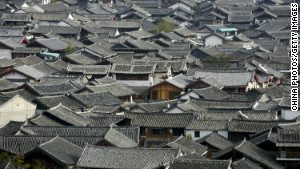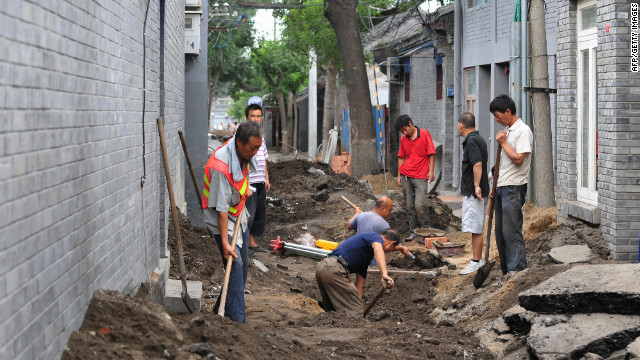Tourism boom threatens China's heritage sites
August 14, 2012 -- Updated 0706 GMT (1506 HKT)
Bristling with
battlements and turrets, the ornate towers were built by families and
villages in need of protection during the late 19th and early 20th
centuries when much of the country was controlled by warlords and
banditry was rife.
Now a UNESCO world heritage site, these days the Kaiping watchtowers, or diaolou as they are known locally, face a threat of a different nature -- the incredible boom in Chinese tourism.
The tiny village of Zili,
which has the largest collection of towers, attracts dozens of tour
buses on weekends. Their passengers are ushered around the towers by
guides sporting red flags and microphones rigged up to loud speakers.

Explore the Great Wall of China

Sports car damages ancient Chinese site
They chase the skinny
chickens that roam about the dirt paths, snap photos, sample "peasant
family food" and buy rustic bamboo souvenirs, while the village's few
remaining elderly residents sit on small plastic stools and look on
bemused.
It's a scene that's
played out at other UNESCO sites across China, where world heritage
status is increasingly being used as a economic vehicle to develop
backward regions, says Chris Ryan, a professor of tourism at The
University of Waikato in New Zealand.
"The idea behind having
this status is that there are conservation, preservation and restoration
issues, where in China it seems to be primarily geared toward promoting
tourism and its economic benefit," says Ryan, who has studied Kaiping
and another world heritage site in Anhui province, eastern China.
According to Ryan,
Chinese made 2.6 billion trips last year, up from just over a billion
seven years ago and numbers are expected to rise further.
"Places that were
previously very remote and didn't see a lot of tourists are now seeing
enormous numbers arriving because they have the money to travel," says
Neville Agnew, group director of the Getty Conservation Institute, which
has worked in China since 1989.
"It's an interesting
phenomenon because it's in complete contrast to the experience in Egypt,
where almost all the visitors are foreigners."
People are getting richer and they have the right to appreciate heritage sites but we need a balance
Jing Feng, UNESCO
Jing Feng, UNESCO
China now has 43 world
heritage sites, the most of any country in the world. Dozens of other
wannabe UNESCO sites across China are preparing bids.
Jing Feng, the
Paris-based chief of UNESCO's Asia and Pacific section, says that the
prestige of world heritage inscription always means an increase in
visitor numbers but acknowledges the pressures of mass tourism in China
are particularly acute.
"People are getting richer and they have the right to appreciate heritage sites but we need a balance," he says.

View of Lijiang in Yunnan province
Tackling the problem is
difficult. Jing singles out Lijiang, an ancient town set in a dramatic
mountain landscape in the southwestern province of Yunnan, as a place
that has struggled to accommodate a surge in tourists.
Designated a world
heritage site in 1997, the town, home to the matriarchal Dongba culture,
now receives 11 million visitors a year and conservation experts have
been shocked by the level of commercialization.
Locals have moved out of the city's ancient core, renting their homes out to businesses.
Jing was part of a
UNESCO monitoring mission to the town in 2008 and local authorities have
pledged to improve visitor management and shut the discos and karaoke
bars that had sprung up.
However, a doubling of admission ticket prices in a bid to reduce visitor numbers has had little impact and officials aim to increase visitor number to 16 million by 2015.
UNESCO has only twice
removed world heritage sites from its list and Jing says there is little
chance, for now at least, that any Chinese sites would lose the
designation because authorities had put forward "corrective measures."
Poor, rural areas
bypassed by China's recent economic boom are those most keen to secure
world heritage status, says Han Li, who works for the Global Heritage
Fund in China.
Local officials often
take out huge loans to build infrastructure to prepare their bid, she
says, and local people, at least, initially welcome the opportunity to
find work outside farming or as alternative to migration.
"Having world heritage
status definitely changes your property values, your investment
opportunities and it's a really big life-saver for a lot of these
places," she says.
It's important to remember that heritage does have its own inherent value and it's not just about a tangible financial return
Han Li, Global Heritage Fund
Han Li, Global Heritage Fund
Officials in charge of
Kaiping's watchtowers have said they aim to attract up to 2 million
visitors each year, up from 100,000 in 2007 when it was first inscribed
as a world heritage site with a view to generating revenues of 50
million yuan (US$7.8 million).

Mogao Caves in Dunhuang, northwest China
How this money will be spent will be key to the future of Kaiping's watchtowers.
So far, it appears that
much of the money generated has been spent on car parks, ticket booths
and landscaping in the four villages featured in tourist brochures.
It's not clear what will
happen to the hundreds of other towers not earmarked for tourist
development. They are used as barns and storage sheds or stand empty and
forlorn despite their protected status.
Many were abandoned
after the Communist victory in 1949 when those with overseas ties fled.
More recently, villagers have left for the booming factory towns on the
other side of the Pearl River Delta.
The challenge for the
local authorities in Kaiping, and at China's other heritage sites, is
how to manage tourists visits so that they bring maximum economic
benefit without harming the heritage sites and those who live nearby.
One radical solution is to limit visitor numbers.
For example, from next
year the Mogao Grottoes in remote Northwestern China plans to allow
6,000 visitors per day, down from up to 11,000 at present, says Agnew at
the Getty Conservation Institute.
The move follows fears
that the moisture from visitors' breath and sweat was harming the
centuries-old cave paintings and Buddhist sculptures.
But this approach is
unlikely to be adopted widely, especially at living sites such as
Lijiang's old town and Kaiping, where economic imperatives are most
likely to trump heritage preservation.
"World heritage sites don't need to be static -- they can bring income and development," says Li at the Global Heritage Fund.
"But I think it's
important to remember that heritage does have its own inherent value and
it's not just about a tangible financial return."

 As developers clamour for land, Beijing has found it hard to protect its ancient lanes, also known as hutongs.
As developers clamour for land, Beijing has found it hard to protect its ancient lanes, also known as hutongs.
ไม่มีความคิดเห็น:
แสดงความคิดเห็น